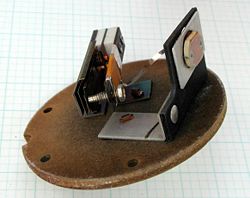Photoresistor
A photoresistor is an electronic component whose electrical resistance changes as the intensity of light shining on it varies. Usually, when it is exposed to a higher intensity of light, its resistance decreases. It is also referred to as a photoconductor, light-dependent resistor (LDR), photocell, or electric eye.
Many types of photoresistors have been developed, serving a variety of uses. For instance, cadmium sulfide cells are used in street lights, camera light meters, clock radios, security alarms, and outdoor clocks. Ge:Cu photoconductors are excellent detectors of far-infrared radiation and are valuable for infrared astronomy and spectroscopy.
How it works
A photoresistor is made of a high-resistance semiconductor. When light of sufficiently high frequency falls on the device, the semiconductor absorbs photons that transfer energy to bound electrons, causing them to jump into the conduction band. The resulting free electrons (and their hole partners) conduct electricity, thereby lowering resistance.
Intrinsic and extrinsic devices
A photoelectric device can be either intrinsic or extrinsic.
- An intrinsic semiconductor has its own charge carriers and is not an efficient semiconductor, for example, silicon. In intrinsic devices, the only available electrons are in the valence band. Therefore, the photons must have enough energy to excite the electrons across the entire bandgap.
- Extrinsic devices have "impurities" added to them, such that the ground state energy (non-excited state energy) of their electrons is closer to the conduction band. Consequently, the electrons don't have to jump as far, and lower energy photons (that is, photons of longer wavelengths and lower frequencies) are sufficient to trigger the device. If a sample of silicon has some of its atoms replaced by phosphorus atoms (corresponding to the "impurities"), extra electrons will be available for conduction. This is an example of an extrinsic semiconductor.
Cadmium sulfide cells
Cadmium sulfide (or cadmium sulphide, CdS) cells rely on the material's ability to vary its electrical resistance according to the amount of light striking the cell. The more light that strikes the cell, the lower its resistance. Although not accurate, even a simple CdS cell can have a wide resistance range, from less than 100 ohms (Ω) in bright light to in excess of ten MΩ in darkness. Many commercially available CdS cells have a peak sensitivity in the region of 500-600 nanometers (nm). The cells are also capable of reacting to a broad range of frequencies, including infrared (IR), visible light, and ultraviolet (UV). They are often found on street lights as automatic on/off switches. They were once used in heat-seeking missiles to sense for targets.
Applications
There are many types of photoresistors. Inexpensive cadmium sulfide cells can be found in many consumer items, such as camera light meters, clock radios, security alarms, street lights and outdoor clocks. They are also used in some dynamic compressors to control gain reduction. At the other end of the scale, Ge:Cu photoconductors are among the best detectors of far-infrared radiation, and they are used for infrared astronomy and infrared spectroscopy.
Circuit symbol
The symbol for a photoresistor, as used in some circuit diagrams, is shown below.
See also
- Infrared
- Optoelectronics
- Phototransistor
- Semiconductor
- Transistor
- Ultraviolet
ReferencesISBN links support NWE through referral fees
- Harrison, Ian. 2004. The Book of Inventions: How'd They Come Up With That?. Washington, DC: National Geographic. ISBN 0792282965
- Hunter, Lloyd P., ed. 1970. Handbook of Semiconductor Electronics: A Practical Manual Covering the Physics, Technology, and Applications of Transistors, Diodes, and Other Semiconductor Devices in Conventional and Integrated Circuits. 3rd ed. New York: McGraw-Hill. ISBN 0070313059
- Sze, S.M., ed. 1994. Semiconductor Sensors. New York: John Wiley. ISBN 0471546097
- Turner, Rufus P. 1980. Solar cells and photocells. 2nd ed. Indianapolis, IN: H.W. Sams. ISBN 0672217112
Credits
New World Encyclopedia writers and editors rewrote and completed the Wikipedia article in accordance with New World Encyclopedia standards. This article abides by terms of the Creative Commons CC-by-sa 3.0 License (CC-by-sa), which may be used and disseminated with proper attribution. Credit is due under the terms of this license that can reference both the New World Encyclopedia contributors and the selfless volunteer contributors of the Wikimedia Foundation. To cite this article click here for a list of acceptable citing formats.The history of earlier contributions by wikipedians is accessible to researchers here:
The history of this article since it was imported to New World Encyclopedia:
Note: Some restrictions may apply to use of individual images which are separately licensed.

